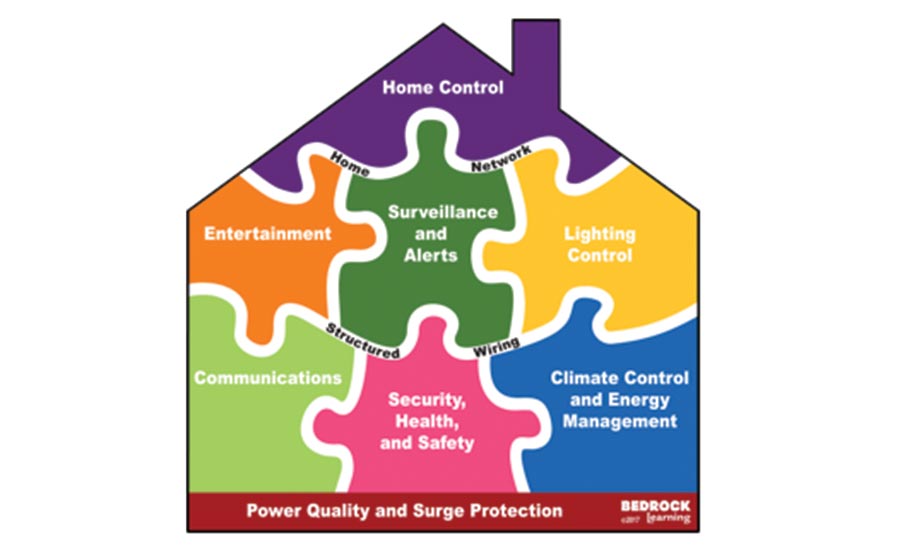The smart home has arrived. Recently smart devices and systems that are affordable, reliable, expandable, and most importantly, desired by consumers, have emerged. The market is huge and the security industry is in the best position to take advantage of this opportunity. To help understand the many facets of a smart home, think of it as a puzzle with the interconnections of the pieces bringing the full picture of a smart home to life.
Let’s take a look at the updated puzzle pieces, starting with security. It continues its mission to protect, monitor, and provide notification of activity or hazards in the home. A smart security system can also control lights, thermostats, water heaters, water valves, garage doors, and just about anything that can happen with a switch, relay, or some sort of signal. They connect to the Internet via the structured wiring/home network piece to provide remote control of, and notification from, the security system with a mobile app.
The Surveillance and Alerts piece also takes advantage of the home network. Cameras around the home share live video for viewing on local displays or through a mobile app. Local activity detected by the security system or a camera can trigger lights on and start recording video.
The structured wiring/home network is integral to other smart home systems, too. It lays the foundation of the Communications piece for phone service, cable service, and Voice-over-IP (VoIP), Internet-based phone service. This also includes intercoms inside the home and intercom doorbells. With a smart doorbell, the person at the door can communicate with the homeowner, even if they aren’t home. Add a camera to the doorbell intercom, and the visitor also can be seen.
The Entertainment piece uses the structured wiring for routing signals around the house, and the home network for access to streaming digital content. Wireless speakers and video signal transmitters make it easy to upgrade an existing home to take advantage of streaming media for music and high-definition video.
The Lighting Control piece enhances the home, increases security, and contributes to energy savings with automated, remote, and scene control. A single switch can set the mood by turning on lighting loads and dimming each to the desired level. At dusk, lights automatically come on. Integrate lighting control with a smart security system and opening the door after sunset triggers lights on, and in away mode can activate lights to maintain the lived-in look.
The Climate Control and Energy Management piece conserves energy and saves money over time. When combined with a smart security system, the thermostat can be set based on status, such as away, home, or asleep. Energy use can also be monitored and managed based on time of day and the weather.
The Home Control piece pulls all of the systems in the house together, integrating them to share status and provide control between systems. A smart security system often includes the home control piece and interfaces with other systems.
The last puzzle piece, Power Quality and Surge Protection, is critical given the many electronics. Protect the home from lightning and electrical surges, including all incoming lines, electrical, phone, cable, satellite, and doorbell. Protect sensitive equipment such as entertainment components and computers against fluctuating power. By monitoring and maintaining clean, quality power, electronics will perform at their best.
The puzzle lines are blurring fast as more devices and systems merge to deliver the smart home. Those companies that get on board with networking and offer the smart home will continue to thrive.
You already have the security piece down, expand with smart security and other puzzle pieces to make your clients’ lives better, strengthen your customer relationships and prosper.



